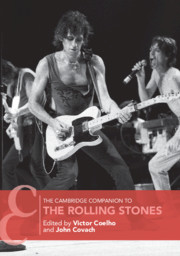Book contents
- The Cambridge Companion to the Rolling Stones
- Cambridge Companions to Music
- The Cambridge Companion to the Rolling Stones
- Copyright page
- Dedication
- Contents
- Illustrations
- Tables
- Notes on Contributors
- Preface
- Abbreviations
- Part I Albums, Songs, Players, and the Core Repertory of the Rolling Stones
- Part II Sound, Roots, and Brian Jones
- Part III Stones on Film, Revival, and Fans
- 9 Shine a Light: The Rolling Stones on Film
- 10 Second Life and the Dynamics of Revival: The Stones after 1989
- Postlude: Being a Rolling Stones Fan is Not a Choice But a State of Mind
- Bibliography
- Index of Songs, Albums, and Visual Media Cited in the Text
- General Index
- References
9 - Shine a Light: The Rolling Stones on Film
from Part III - Stones on Film, Revival, and Fans
Published online by Cambridge University Press: 23 August 2019
- The Cambridge Companion to the Rolling Stones
- Cambridge Companions to Music
- The Cambridge Companion to the Rolling Stones
- Copyright page
- Dedication
- Contents
- Illustrations
- Tables
- Notes on Contributors
- Preface
- Abbreviations
- Part I Albums, Songs, Players, and the Core Repertory of the Rolling Stones
- Part II Sound, Roots, and Brian Jones
- Part III Stones on Film, Revival, and Fans
- 9 Shine a Light: The Rolling Stones on Film
- 10 Second Life and the Dynamics of Revival: The Stones after 1989
- Postlude: Being a Rolling Stones Fan is Not a Choice But a State of Mind
- Bibliography
- Index of Songs, Albums, and Visual Media Cited in the Text
- General Index
- References
Summary
Songs by the Rolling Stones are used in the soundtracks of so many contemporary film and television productions that any attempt to count them would be a fool’s errand. The group’s role as the stars or principal subjects of documentary films concerned with popular music and culture is far easier to chronicle, however, but no less instructive in terms of demonstrating the central influence of the Stones within the world of motion pictures. It is not an exaggeration to suggest the Rolling Stones represent the most documented musical group in the history of cinema. It is explained, in part, as the result of their unrivalled longevity, but equally for the timing of their emergence on the scene and the ease with which they both invited and adapted to the presence of cameras in their professional lives. Looking at Dominique Tarlé’s still-photography (1971) captured during the band’s exile in France and the recording of Exile on Main Street at Villa Nellcôte, alongside home footage from the period (now available within the Stones in Exile DVD, Stephen Kijak, USA, 2010), it becomes clear that the band was surrounded by motion picture cameras – those of professionals as well as their own – to an ubiquitous degree. Over the course of their career, the Rolling Stones embraced documentary film-making and the opportunities made available through increasingly sophisticated, progressively mobile, synchronized sound film technology in a manner rivalled by few, if any, of their contemporaries. Early on, they understood the power of the moving image and the degree to which it could both secure and perpetuate the mythology of the band, collaborating with a range of innovative filmmakers and artists whose approaches would facilitate such a project of self-creation. However, after public controversies, personal turmoil, and diminishing financial returns, the Rolling Stones would begin to exert an increasing amount of control over their cinematic representation, which results in work through the 1980s, 1990s and 2000s that rarely, if ever, demonstrates the innovation and intimacy for which the first decade of their documentary appearances is so celebrated.1
- Type
- Chapter
- Information
- The Cambridge Companion to the Rolling Stones , pp. 165 - 183Publisher: Cambridge University PressPrint publication year: 2019



